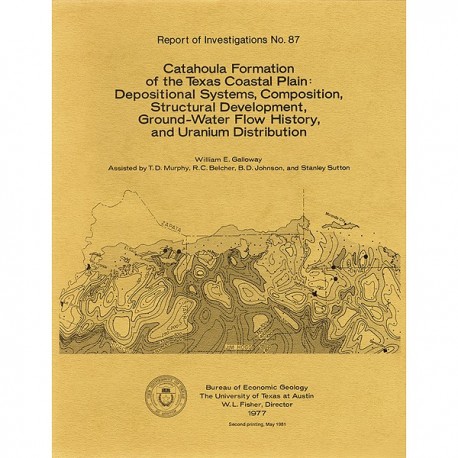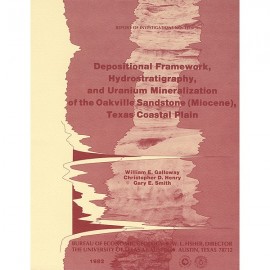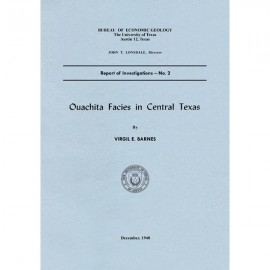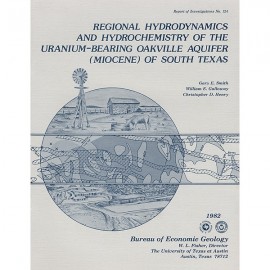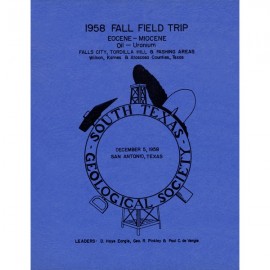Reports of Investigations
-
Books & Reports
- Reports of Investigations
- Guidebooks
- Udden Series
- Geological Circulars
- Down To Earth
- Atlases of Major Oil and Gas Reservoirs
- Texas Memorial Museum Publications
- Environmental Geologic Atlas of the Texas Coastal Zone
- Mineral Resource Circulars
- Other Reports
- Seminars and Workshops
- Handbooks
- Submerged Lands of Texas
- Symposia
- Annual Reports
- Open File Reports
-
Maps & Cross Sections
- Thematic Maps
- Miscellaneous Maps, Charts & Sections
- Geologic Atlas of Texas
- STATEMAP Project Maps
- Geologic Quadrangle Maps
- Cross Sections
- Highway Geology Map
- Energy and Mineral Resource Maps
- Shoreline Change and Other Posters
- Wilcox Group, East Texas, Geological / Hydrological Folios
- Bouguer Gravity Atlas of Texas
- River Basin Regional Studies
- Featured Maps
- Posters
- Teachers & the Public
-
Geological Society Publications
- Gulf Coast Association of Geological Societies
- Alabama Geological Society
- Austin Geological Society
- Corpus Christi Geological Society
- Houston Geological Society
- Lafayette Geological Society
- Mississippi Geological Society
- New Orleans Geological Society
- South Texas Geological Society
- GCS SEPM Publications
- Historic BEG & UT Series
Catahoula Formation...Texas Coastal Plain: Depositional Systems, Composition, Structural Development, Ground-Water
RI0087
Catahoula Formation of the Texas Coastal Plain: Depositional Systems, Composition, Structural Development, Ground-Water Flow History, and Uranium Distribution, by W. E. Galloway. 59 p., 31 figs., 2 tables, 4 plates, 2 appendices, 1977. ISSN: 0082335X: Print Version.
A free, digital version of this publication can be found on: Texas ScholarWorks
RI0087. Catahoula Formation of the Texas Coastal Plain: Depositional Systems, Composition, Structural Development, Ground-Water Flow History, and Uranium Distribution, by W. E. Galloway. 59 p., 31 figs., 2 tables, 4 plates, 2 appendices, 1977. ISSN: 0082335X: Print.
To purchase this publication as a downloadable PDF, please order RI0087D.
ABSTRACT
The Catahoula Formation of the Texas Gulf Coastal Plain consists of two depositional systems--the Gueydan bedload fluvial system of the Rio Grande embayment and the Chita-Corrigan mixed load fluvial system of the Houston embayment. Both systems contain distinctive fluvial channel-fill, crevasse splay, floodplain, and lacustrine facies, which tend to persist vertically through the section. The paleoclimate varied from subarid in the Gueydan system to humid in northeastern parts of the Chita-Corrigan system. Gueydan sands are dominated by plagioclase feldspar and volcanic rock fragments reflecting a western source; in contrast, Chita-Corrigan sands are quartzose and were primarily reworked from mixed sedimentary terranes. Clay composition reflects alteration to montmorillonite and kaolinite of large volumes of volcanic ash deposited in both systems in response to pedogenesis and shallow burial diagenesis.
Growth faults initiated by early Tertiary deltaic progradation extend up into the Catahoula and profoundly influence trends of fluvial sand units and post-depositional ground-water flow. Consequently, fault zones may localize uranium mineralization, but faulting is not necessary for development of commercial deposits.
Diagenetic features, distribution of trace uranium in fine-grained tuffaceous facies, and reconstructed ground-water flow history in the Catahoula provide the basis for interpretation of a terrigenous coastal plain uranium cycle.
1. Uranium was leached from volcanic ash soon after deposition by pedogenic processes and moved into shallow ground-water circulation cells.
2. Oxidizing uranium-enriched waters entered semi-confined aquifer sands in areas of regional recharge.
3. Geometry of the flow system was determined by the three-dimensional facies and structural framework of the aquifer system.
4. Uranium was concentrated by aqueous geochemical gradients as discrete mineralization fronts that were closely associated with iron oxidation fronts. Uranium was preferentially deposited where facies changes or faulting induced cross-stratal flow from permeable fluvial channel facies into interbedded or less permeable overbank facies.
5. Post-mineralization decrease of regional and local ground-water flux has resulted in reequilibration of large parts of the aquifer with the regionally reducing subsurface environment.
The inferred uranium cycle provides criteria that can be used to compare the uranium potential of the Gueydan and Chita-Corrigan fluvial systems and to determine the possible distribution and nature of mineralization within each depositional system. These criteria apply similarly to other potential coastal plain uranium host systems.
Keywords: Catahoula Formation, Chita-Corrigan fluvial system, depositional systems, ground-water flow, Gueydan fluvial system, Texas, Texas Coastal Plain, uranium
Citation
Galloway, W. E., 1977, Catahoula Formation of the Texas Coastal Plain: Depositional Systems, Composition, Structural Development, Ground-Water Flow History, and Uranium Distribution: The University of Texas at Austin, Bureau of Economic Geology, Report of Investigations No. 87, 59 p.
